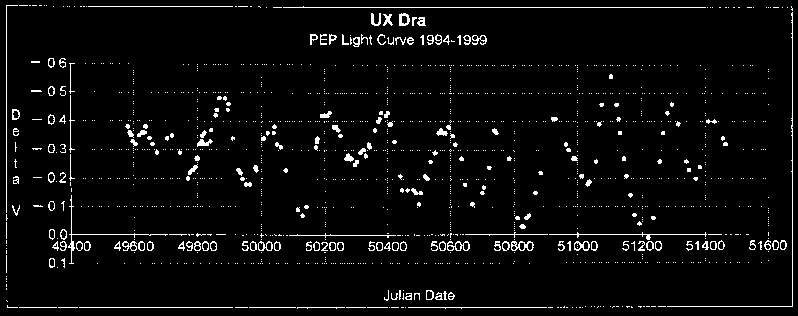Help |
About |
Articles |
Objects |
Lightcurves |
Statistics |
Home
from VSSC 102
PEP FROM THE BACKYARD OBSERVATORY AT RYDE
THE FIRST 5 YEARS (PART 2)
Kevin West
This series of articles sets out to show PEP light curves with some
provisional analysis, and to compare these with any available visual light
curves. The stars are all part of a programme of the long term monitoring of
high declination, bright variables, conducted by the author. The data is
readily available from the BAA database. It is intended that a more detailed
compilation of the articles will be submitted for publication in the BAA
Journal.
The programme comprises:
Psi 1 Aur, UU Aur, BR CVn, TU CVn, Y CVn, V465 Cas, Mu Cep, UX Dra, g Her,
OP Her, Delta 2 Lyr, R Lyr, XY Lyr, X Per, ST UMa, VY UMa, RR UMi.
Four PEP lightcurves by the author are give below, together with visual
lightcurves provided by Dave McAdam from the VSS database.
UX Dra
Very early observations were published in IBVS and the analysis showed a
period of 168 days. With the benefit of a longer series, recent work by 2
independent analysts have given 178 and 179 days. A nicely pulsating longer
period variable well suited to our limited UK observing opportunities.


608 visual observations by;-
J M F Andujar, P Craven, B S Crawford, S Elliott, S J Evans, R B I Fraser,
C Henshaw, T Markham, I A Middlemist, B R M Munden, G Pointer, G Ramsey,
A Smeaton, M D Taylor.
ST UMa
A relatively poorly observed variable that was picked up at the suggestion of
Melvyn Taylor, I believe after questions were raised about its variabililty.
A healthy total range to date of almost 1 magnitude. I have only one analysis
of this thin data which gives 111 days. The only listed information I have is
81 days(?) from a 1970 Binocular Sky Society chart. More data needed.


784 visual observations by;-
S W Albrighton, A R Baransky, P Bibbings, N M Bone, J S Day, S J Evans,
R B I Fraser, B H Granslo, C Henshaw, T Markham, I A Middlemist,
Volodymir G Mormyl, I P Nartowicz, M J Nicholls, B O'Halloran, G Pointer,
G Ramsey, D M Swain, M D Taylor, J Toone, Erol Yusuf.
Y CVn
Another longer period variable for which the weather windows and seasonal
gaps don't have too detrimental an effect on the appearance of the light
curve. As I understand it, Fourier analysis is almost unaffected by irregular
gaps in the data. However, there is some disageement on the periods found
within this particular data. One analyst found a period of 690 days and
another found 240 and 310 days. Hopefully more data will eventually resolve
this.


1184 visual observations by;-
S W Albrighton, A R Baransky, R Billington, N M Bone, R C Dryden, S J Evans,
R B I Fraser, D Gill, B H Granslo, C Henshaw, Steve Johnston, R Livingstone,
T Markham, R A Marriott, I A Middlemist, Volodymir G Mormyl, I P Nartowicz,
B O'Halloran, G Pointer, G Ramsey, D M Swain, M D Taylor, J Toone,
Erol Yusuf.
Delta 2 Lyr
The first quarter of the data analysed for an IBVS gave a period around 79
days. The longer baseline of the complete dataset (to date) has provided a
much cleaner power spectrum with possible periods evident at 1225, 88.2 and
65.6 days. Independent analysis gives some confimation with 68 and 89 day
periods seen.


117 visual observations by;-
T Markham, I P Nartowicz. (data entry incomplete)
For further information please contact:
Kevin West at 5, Edward St., Ryde, Isle of Wight. England. PO33 2SH
Tel: 01983 614591. E-mail
Top of page |
Help |
About |
Articles |
Objects |
Lightcurves |
Statistics |
Home







